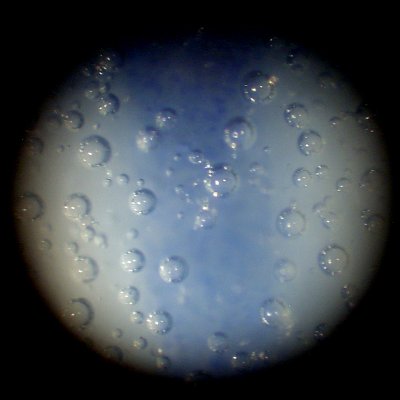
These pictures are taken through a microscope at 100 X enlargement of a very thin line in the decoration on a Chinese porcelain dish which from general criteria are datable to the late Guangxu/early Republic Period, first decades of the 20th century, clearly demonsting a "Hollow Line". "Hollw lines" occurs in the entire decoration of this dish as well as in the mark, which imitates a Ming period mark. In this pictures the bubble structure in the glaze is unaffected by the blue area below.

This picture is taken through a microscope at 100 X enlargement of a very thin line in the decoration of a Chinese porcelain dish shard from the excavation of the cargo of the East Indiaman Gotheborg, which foundered in 1745. All porcelain pieces in this cargo was most likely from the 1720-40 period. The pictures demonstrates a normal underglaze blue line with no "Hollow Line". The shard and its decoration is typical for the cargo. It could be noted that in this picture there seems to be less bubbles in the glaze over the blue areas.
Photo: Jan-Erik Nilsson, 2003
Tendency of the cobalt particles to concentrate on the outer edges of underglaze blue brush strokes or washes.
The cause is not explained as far as I know. In later porcelain, the effect might have been caused by the porcelain being bisque fired before the decoration being applied.
The technique of bisque firing could have entered the Chinese porcelain industry with the Japanese technology that was introduced during the first decades of the 20th century, where this is the common practice.
In the original theory published by Calvin Chou in 1978 a late Qing time span was suggested during which this would have occured. To me the "hollow line feature" generally strongly suggests a late Guangxu/early Republic date, but similar effects can be found in all periods.
A